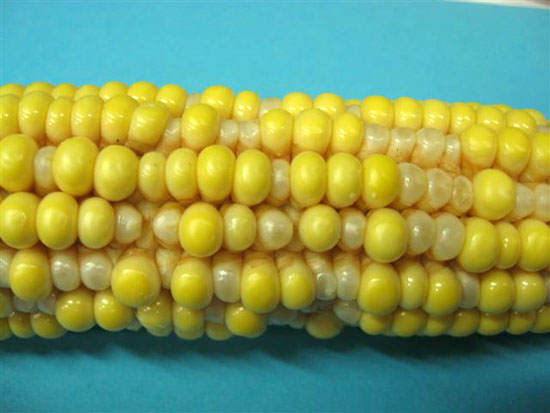
Left – Ear showing translucent “bubble” kernels as a result of injury from a late glyphosate application. Right – An injured ear later in development where the affected kernels have shrunk and collapsed. Photos by Dan Emmert and Curt Hoffbeck, DuPont Pioneer field agronomists, 2010 (L) and 2014 (R).
Symptoms:
Initial symptoms of this oddity are the appearance of plump, translucent, liquid-filled kernels scattered randomly among already-dented kernels throughout an otherwise normal-looking ear (Nafziger, 2010).” As these kernels mature, they appear hollow, eventually abort and collapse, resulting in a shriveled kernel appearance not unlike mature sweet corn kernels. Adjacent kernels expand to fill the gaps left by the damaged kernels, resulting in the ears having a jumbled appearance (See Jumbled Kernel Syndrome)
The “bubble kernels” contain only clear liquid with perhaps a small amount of white material–probably starch–that may later turn yellow (Nafziger, 2010). Liquid in these “bubbles” eventually dries up, leaving what are essentially seed coats without an embryo or endosperm, “Bubble kernels” usually flatten as kernels on both sides press in during grainfill if there are only a few, scattered “bubble kernels” on an ear.
Cause:
“Translucent” and “bubble kernel” kernels often result from off-label late glyphosate application (DuPont Pioneer (2014)).
-
Many glyphosate-resistant hybrids are not homozygous for the trait – one parent (typically the female parent) is resistant and the other is not (DuPont Pioneer, 2014).
-
The resulting F1 hybrid plants are all heterozygous for the trait, with one resistant and one susceptible allele. The resistant allele is dominant, so the hybrid plants are all glyphosate-resistant.
-
The fertilized kernels on the plant represent the F2 generation. Since the F2 embryos are all the product of two heterozygous F1 parents, they will segregate out into 25% homozygous resistant, 50% heterozygous resistant, and 25% homozygous susceptible.
-
This means that approximately 25% of the developing kernels on an ear are susceptible to damage if exposed to glyphosate.
Management:
Follow label guidelines concerning Rounrup application. Roundup WeatherMax® can be applied over the top to corn with Roundup Ready® 2 Technology up to the V8 stage or until the corn reaches 30 inches tall, whichever comes first..For corn 30 to 48 inches tall, treatments can only be made using a ground applicator equipped with drop nozzles.
References:
DuPont Pioneer. 2014. Corn Ear Injury Risk with Off-Label Glyphosate Applications. Crop Focus. DuPont Pioneer Agronomy Sciences. https://www.pioneer.com/CMRoot/Pioneer/US/Non_Searchable/agronomy/cropfocus_pdf/off_label_glyphosate_app_corn.pdf (URL verified 8/26/2019)
Nafziger, E. 2010. “Bubble Kernel” in Corn. The Bulletin. University of Illinois. Issue No. 16, Article 8. Available at http://bulletin.ipm.illinois.edu/article.php?id=1387 [URL verified 3/25/2019].
Nielsen, R.L. 2010. Jumbled Kernel Symptom in Corn & Late Glyphosate Application. Available at https://ag.purdue.edu/btny/ppdl/Pages/POTW_old/12-13-10.html [URL verified 3/25/2019].

